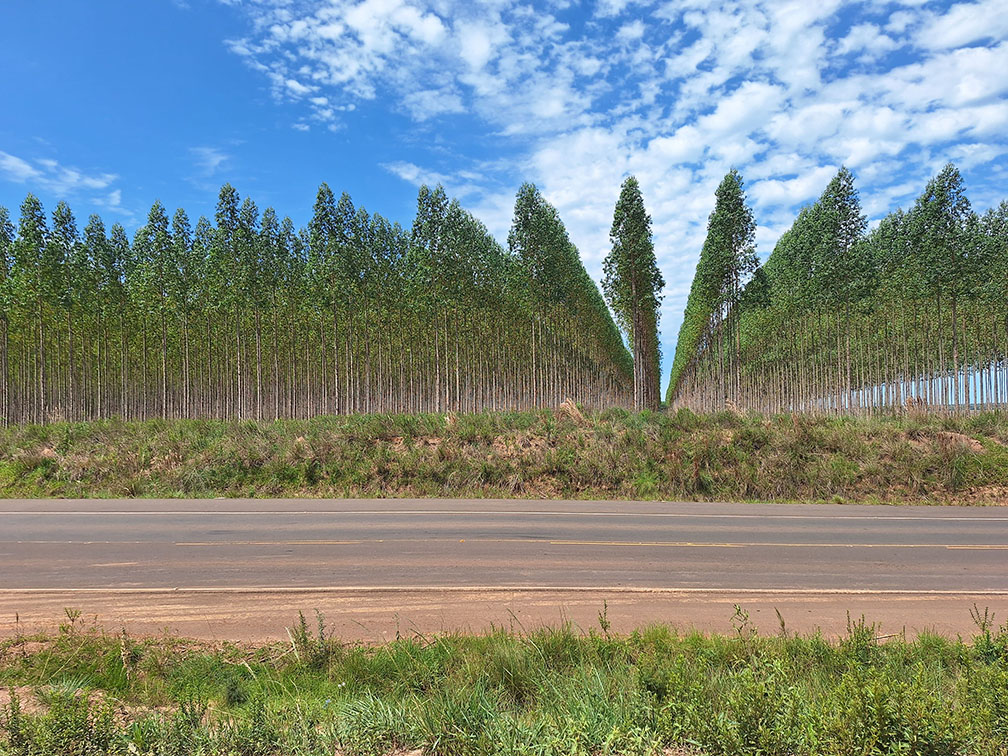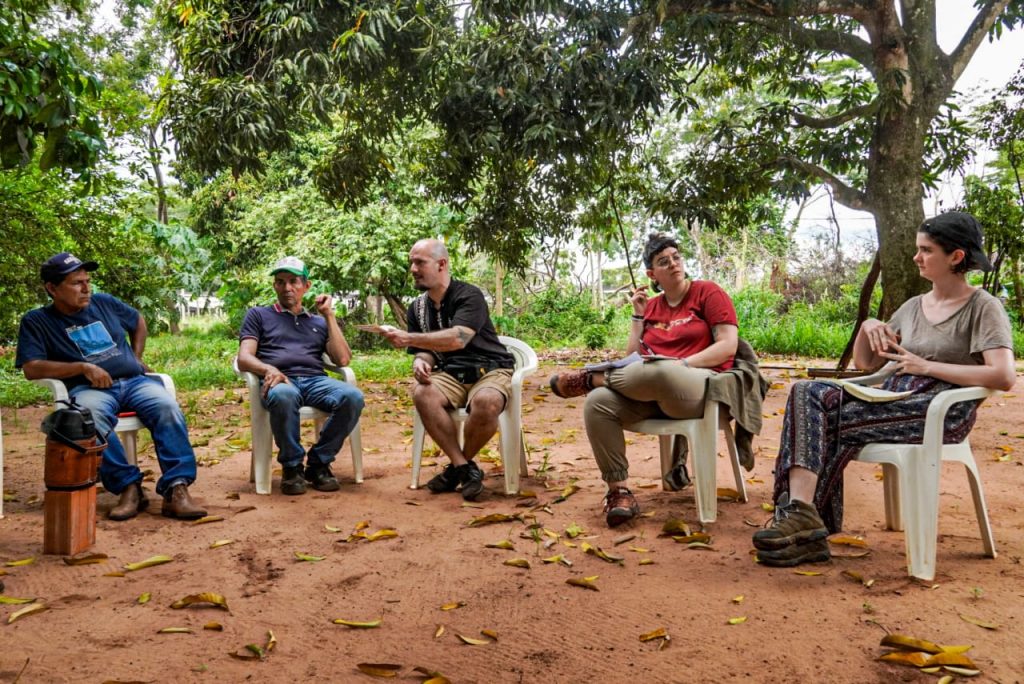Jamie C. Gagliano 2023 Field Report
Paraguay, among other nations in the global South, has become a veritable sink for global carbon emissions. The principal driver in Paraguay is eucalyptus as a form of reforestation. Whereas Paraguay’s soy economy has been well documented for its rapid expansion, ecological devastation, and violent displacement of campesino and Indigenous communities[1], eucalyptus is presented as a necessity to prevent future deforestation and mitigate the effects of climate change through carbon capture. Yet, eucalyptus has gained traction principally as a commodity for various wood, paper, and construction materials. This tree circulates symbolically as reforestation and materially as a commodity. In this tension between reforestation and commodity, the major actors involved in planting eucalyptus tout their work as the key to building a sustainable industry driven by modern technology and international investment. Yet, to make this economy happen on a large scale entails a significant reworking of local livelihoods and ecologies.

The most recent National Agricultural Census (Censo Agropecuario Nacional, or CAN), carried out in 2022, demonstrates significant changes from the one before (completed in 2008) in terms of Paraguay’s forestry sector. The 2022 census indicates an 82% expansion in land occupied by the forestry sector. Even more notably, whereas the 2008 census indicated that around 36% of the forestry sector was devoted to eucalyptus, by 2022 this number has jumped to 94%.[2] This is to say that as of 2022, there are 259,639 hectares of eucalyptus in a sector that indicates it only plans on further expanding, particularly through largescale plantations. This rapid shift toward eucalyptus has largely been financed through international banks, especially in Europe and from the UN Green Climate Fund[3], which have a vested interest in rapidly expanding economies ostensibly aimed at carbon capture, such as monocrops of eucalyptus. All of this is occurring through a massive wave of de-peasantization in the countryside, where families are sharing smallerand smaller plots of land coupled with a significant decline in rural jobs[4] further incentivizing rural outmigration.[5]
In addition to these dynamics of land concentration, the particular ecologies of eucalyptus warrant attention. Debates surge about the extent to which eucalyptus is more demanding on local soils than native trees, particularly regarding water consumption. As droughts are becoming more intense and fires more prevalent, the role that large eucalyptus plantations might play in exacerbating water table depletion and providing fodder for wildfires is an important question.[6] Eucalyptus is highly regarded by the forestry sector for its rapid growth, although at a minimum it takes 5 years to begin harvesting low quality wood. The greatest profit margins are for high quality wood used in construction materials, which requires a 10 to 12year waiting period. Whereas for now, planting trees means reforestation, it is unclear how many cycles of eucalyptus will be viable for these companies investing large amounts of capital in the tree. Meanwhile, eucalyptus is dramatically altering local ecosystems. In southwestern Caazapá, a region whose low-lying areas are dominated by marshes and ranching, eucalyptus has become big business. Here, part of the work of eucalyptus plantations is drying the soil from marshes – which are useful for grazing cattle – and rice paddies. This represents a significant ecological shift not only for large-scale agribusiness but has ripple effects for the local campesino communities which are vulnerable to wildfires and drought.
Field Research
I am writing this report in the midst of my fieldwork, which has taken me to a stretch of highway between three districts (Maciel, Dr. Moises Bertoni, and Yegros) in southwestern Caazapá department. Here, multiple major corporations have planted eucalyptus for eleven miles along the highway that stretches several miles deep. In total, they have planted more than 200 square miles of eucalyptus in this region, with plans to expand through renting out more family plots and old cattle ranching properties. Much of the investment required to achieve such a scaled economy has come from European financial firms, particularly from Germany, Austria and Sweden. While the northeast of Caazapá has been penetrated by soy and characterized by intense land conflicts, western Caazapá until recently has been relatively quiet and has not attracted much in the way of foreign investment. When Route 8 was paved in 2016, this began to change. The topography here, stretching north from the Tebicuary River, has not been suitable for the mechanized apparatuses required by GM soy and other key commodities at a large scale. The soil does not drain as well as the famed tierra roja (red earth) of much of eastern Paraguay, and the number of wetlands also has made the region better suited to ranching. The name Caazapá derives from Guaraní for “beyond the forest”, indicating this region historically has been a transition zone between the Bosque Atlántico to the east and the Selva Central to the northwest. While the region has been a challenge for agribusiness, campesinos have been staking out livelihoods here since the colonial era. They are surrounded by clusters of small campesino communities, some dating back to the 19th century.

So far in conducting this work, I have interviewed forestry engineers employed by the different companies and interviewed nearby campesino associations. As this work continues over the next several months, I will continue to build on relationships in the region and interview dayworkers employed by the companies, as well as spend time in the greenhouses that provide the eucalyptus saplings for large
agribusinesses. In doing so, I aim to trace the eucalyptus economy as a whole not just the land it occupies. This ethnography of the eucalyptus economy is being conducted with the support of key research institutes and campesino associations who are interested in the question of how eucalyptus is altering the region.
Please see the full report here.
Acknowledgements
The funding for this research comes from the Fulbright Doctoral Dissertation Research Advancement award and support from the Conference for Latin Americanist Geographers (CLAG). The contribution from CLAG has gone toward supporting a Guarani tutor to continue advancing my capabilities in this language and has been used for transportation in the region of Caazapá to conduct interviews and meetings. The support from CLAG has been key for supporting my dissertation work, allowing me to conduct more meetings and interviews.
[1] Ezquerro-Cañete, Arturo. (2016). Poisoned, dispossessed and excluded: a critique of the neoliberal soy regime in Paraguay. Journal of Agrarian Change, 16(4): 702-710; Hetherington, Kregg. (2020) Government of Beans. Durham: Duke University Press.
[2] Rojas Villagra, Luis. (2023). Censo agropecuario nacional 2022: desconfianza y preocupación en torno a los resultados.
Asuncion: Heñoi.
[3] Yampey, Omar. (2022). No son bosques: un modelo anti-ecologico de negocio forestal se cierne sobre el Paraguay, el caso de la Forestal Apupú y Forestal San Pedro. Asunción: Heñoi.
[4] While campesino families have tended to rely principally on small cash crops (cotton, sesame, yerba mate) to generate income on the farm, during seasons where there is no significant labor on the family farm often meant going to larger farms for seasonal work to generate income. This has long been part of campesino pluri-activity, but newer, largely mechanized crops like GM soy and corn often require little outside manual labor.
[5] Rojas Villagra, (2023). Censo Agropecuario 2022.
[6] Patriarca, Victor & Guillermo Achucarro. (2023). Entre incendios forestales e inundaciones. Informes Especiales, 65. Asuncion: BASE-IS.


















